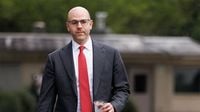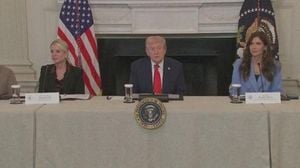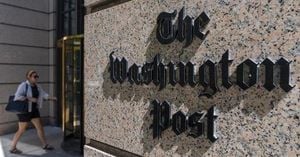It’s not every day that a new face at the Federal Reserve Board of Governors makes headlines by upending the consensus on interest rates—but this week, Stephen Miran, the latest Trump appointee to the Fed, did just that. Miran, who was sworn in mere hours before the Federal Open Market Committee (FOMC) met on September 17-18, 2025, arrived with a bold prescription: slash interest rates five times by year’s end, and do it faster than anyone else on the committee would dare.
That stance, as reported by Reuters, immediately set Miran apart as an outlier. He cast the lone dissenting vote in favor of a 50 basis point rate cut—double the 25 basis point reduction ultimately approved by the FOMC. "I was the only supporter for a 50-basis-point cut," Miran acknowledged in a CNBC interview following the meeting. "However, I was sworn in about an hour before the meeting. I'll be making arguments in coming weeks and months...That's starting now and that's going to go a lot further."
Miran’s argument for aggressive rate cuts rests on a view of the U.S. economy that diverges sharply from many of his Fed colleagues and mainstream economists. As he explained on Fox Business Network’s "Kudlow," Miran believes that several powerful disinflationary forces are at play. "My view is that there's a number of disinflationary forces in the works that are coming into play that will be bringing inflation down in the near term," he said. He specifically pointed to lower immigration and the resulting reduction in housing demand as key reasons inflation would soon ease.
"The supply of housing adjusts only very sluggishly, and if you throw millions of new residents, millions of immigrant residents, into a relatively fixed supply of housing, you get lots of shelter inflation, rents go higher. We've stopped that. The border is closed, and, you know, probably well over a million migrants have gone home in the first half of this year alone. That, to me, is profoundly disinflationary, and it's in the pipeline," Miran told Fox Business Network.
But it’s not just immigration where Miran’s view stands out. He has repeatedly disputed the idea—widely held among economists and inside the Fed—that President Trump’s tariffs are stoking inflation. "I don't see any material inflation from tariffs," Miran told CNBC. "I see no evidence that it's occurred." In another interview, he elaborated, "To me, if I were going to look for evidence of inflation of tariffs, I would think that import-intensive core goods would be inflating more than overall core goods, which is not the case."
That position is in stark contrast to the prevailing sentiment at the Fed and among many economic analysts. As Quartz and Reuters have noted, the central bank has been reluctant to cut rates too aggressively, citing concerns that Trump’s tariffs are indeed pushing up consumer prices. Inflation remains above the Fed’s 2% target, and it has ticked higher in recent months as Trump’s sweeping campaign of import taxes has taken effect. Yet Miran maintains that "foreign countries are paying the cost of tariffs," contradicting studies like one from the Peterson Institute for Economic Analysis, which found U.S. businesses were absorbing most of the tariffs and passing costs onto consumers as inventories run out.
On the question of Fed independence—a perennial concern whenever politics and central banking collide—Miran has been at pains to stress his autonomy. He took unpaid leave from his role as chairman of the Council of Economic Advisers at the White House to serve on the Fed, and he’s promised to resign from the White House post immediately if he’s nominated for a longer Fed term after January 2026. "I will do independent analysis based on my interpretation of the data, based on my interpretation of the economy, and that is all that I will do," Miran said, adding that his brief congratulatory call with President Trump before the FOMC meeting did not touch on policy or his voting intentions.
Still, his dual role—he is the first Fed governor since the 1930s to also hold a White House position—has raised eyebrows. Some economists and Fed watchers worry that Miran’s appointment, along with Trump’s attempt to remove another governor, Lisa Cook, signals a broader effort to bring the independent central bank under political sway. As Reuters reported, Fed Chair Jerome Powell addressed these concerns directly, saying, "The only way for any voter to really move things around is to be incredibly persuasive, and the only way to do that in the context in which we work is to make really strong arguments based on the data and your one's understanding of the economy."
Other Fed officials, including San Francisco Fed President Mary Daly and Minneapolis Fed President Neel Kashkari, have continued to advocate for a more gradual pace of rate reductions. Daly summarized the mainstream approach: "We took a 25 basis-point rate cut to try to support the labor market through the slowing that we've seen, and achieve both of our goals." Kashkari, for his part, has shifted toward supporting further cuts due to weakening job creation but downplays inflation risks from tariffs. "I believe the risk of a sharp increase in unemployment warrants the committee taking some action to support the labor market," Kashkari wrote in an essay, adding, "there's little risk of a sharp rise in inflation from tariffs."
Despite the controversy, Miran’s arrival at the Fed was described by Kashkari as "like any other transition where somebody comes in and everybody says 'hey, welcome to the table. We look forward to hearing your contributions.' And then everybody went about their business as normal." Kashkari also emphasized that the public and Congress still have faith in the Fed’s independence, noting the recent decline in the 10-year Treasury yield as evidence of market confidence.
Looking ahead, Miran has promised to lay out his economic reasoning in meticulous detail during a speech in New York on Monday, September 22, 2025. "I'm going to give a full accounting for my economic views, and walk through in meticulous detail the economics and the arithmetic behind getting to those numbers," he said on CNBC. Miran’s projections—he favors a fed funds rate between 2.75% and 3% by year’s end, about three-quarters of a point lower than the next most dovish forecast—underscore just how far outside the Fed’s mainstream he currently sits.
Meanwhile, the Trump administration continues to push its economic agenda, including a new proposal to charge companies $100,000 per year for H-1B worker visas—a move that could have major implications for the tech sector, which relies heavily on skilled foreign labor.
As the debate over the direction of U.S. monetary policy intensifies, Miran’s tenure at the Fed will be closely watched. His willingness to break with consensus and his insistence on independence will test both the institution’s traditions and its ability to navigate a rapidly shifting economic and political landscape.




